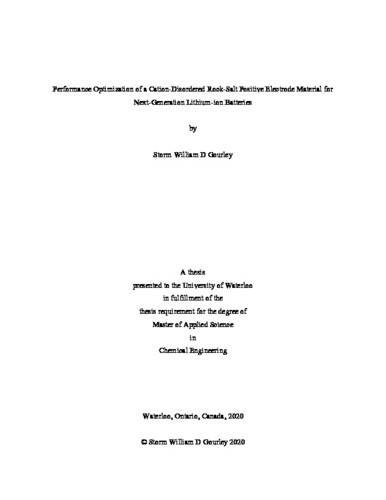| dc.contributor.author | Gourley, Storm William D | |
| dc.date.accessioned | 2020-08-28 17:50:09 (GMT) | |
| dc.date.available | 2022-08-29 04:50:05 (GMT) | |
| dc.date.issued | 2020-08-28 | |
| dc.date.submitted | 2020-08-13 | |
| dc.identifier.uri | http://hdl.handle.net/10012/16189 | |
| dc.description.abstract | The growing threat of climate change has sparked a shift in societal norms surrounding the reliance on fossil fuels for our energy and transportation sectors. Driven by this shift, the global demand for sustainable energy sources and advanced energy storage technologies has seen a considerable increase over the last decade. In particular, electrification of the automotive industry coupled with the continued growth of the consumer electronics market and the need for stabilization of intermittent energy sources at the grid level has caused an unparalleled increase in utilization of lithium-ion batteries. Electric vehicle sales in 2016 represented only 0.2% of the market share but is anticipated to reach over 86% by 2060. Further market penetration of electric vehicles is currently inhibited by the battery pack performance and cost, due to the limitations of modern batteries and the use of expensive raw materials. The potential growth of this market has galvanized research efforts to improve the cost-to-range ratio of lithium-ion batteries for use in next-generation electric vehicles. The focus of these efforts has primarily been in the development of new electrode materials and the improvement of those already commercialized. Disordered rocksalts (DRX) are an emerging class of positive electrode material for lithium ion batteries that offers high energy density (~1000Wh/kg) capable of meeting range targets set for future electric vehicles. Although this material has promising energy metrics, DRX cathodes suffer from low electrochemical stability and poor rate performance that inhibit their deployment in modern applications. This thesis focuses on improving the cycling stability of a DRX cathode, Li1.25Mn0.5Nb0.25O2, through the modification of particle morphology. This work presents an optimized synthesis pathway for the formation of single crystal particles with increased structural stability. The use of surface coatings is also examined as a strategy to improve the rate performance and surface level stability of the DRX material. Physical and electrochemical results for the series of prepared cathodes are detailed and new insight into the potential of these strategies to push DRX materials towards commercialization is discussed. | en |
| dc.language.iso | en | en |
| dc.publisher | University of Waterloo | en |
| dc.subject | energy | en |
| dc.subject | batteries | en |
| dc.subject | lithium-ion | en |
| dc.title | Performance Optimization of a Cation-Disordered Rock-Salt Positive Electrode Material for Next-Generation Lithium-ion Batteries | en |
| dc.type | Master Thesis | en |
| dc.pending | false | |
| uws-etd.degree.department | Chemical Engineering | en |
| uws-etd.degree.discipline | Chemical Engineering | en |
| uws-etd.degree.grantor | University of Waterloo | en |
| uws-etd.degree | Master of Applied Science | en |
| uws-etd.embargo.terms | 2 years | en |
| uws.contributor.advisor | Chen, Zhongwei | |
| uws.contributor.affiliation1 | Faculty of Engineering | en |
| uws.published.city | Waterloo | en |
| uws.published.country | Canada | en |
| uws.published.province | Ontario | en |
| uws.typeOfResource | Text | en |
| uws.peerReviewStatus | Unreviewed | en |
| uws.scholarLevel | Graduate | en |

